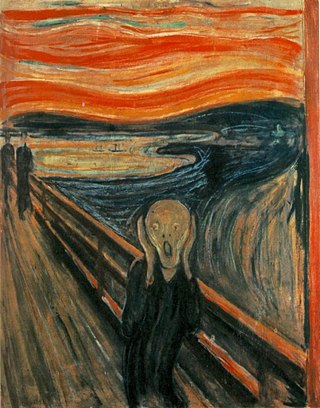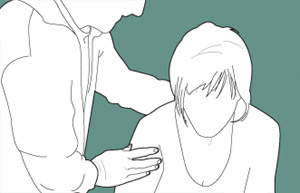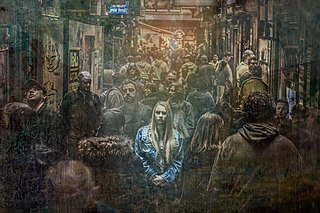Related Research Articles

Anxiety is an emotion which is characterised by an unpleasant state of inner turmoil and includes feelings of dread over anticipated events. Anxiety is different from fear in that fear is defined as the emotional response to a present threat, whereas anxiety is the anticipation of a future one. It is often accompanied by nervous behavior such as pacing back and forth, somatic complaints, and rumination.

A phobia is an anxiety disorder, defined by an irrational, unrealistic, persistent and excessive fear of an object or situation. Phobias typically result in a rapid onset of fear and are usually present for more than six months. Those affected go to great lengths to avoid the situation or object, to a degree greater than the actual danger posed. If the object or situation cannot be avoided, they experience significant distress. Other symptoms can include fainting, which may occur in blood or injury phobia, and panic attacks, often found in agoraphobia and emetophobia. Around 75% of those with phobias have multiple phobias.
Paranoia is an instinct or thought process that is believed to be heavily influenced by anxiety, suspicion, or fear, often to the point of delusion and irrationality. Paranoid thinking typically includes persecutory beliefs, or beliefs of conspiracy concerning a perceived threat towards oneself. Paranoia is distinct from phobias, which also involve irrational fear, but usually no blame.

Anxiety disorders are a cluster of mental disorders characterized by significant and uncontrollable feelings of anxiety and fear such that a person's social, occupational, and personal functions are significantly impaired. Anxiety may cause physical and cognitive symptoms, such as restlessness, irritability, easy fatigue, difficulty concentrating, increased heart rate, chest pain, abdominal pain, and a variety of other symptoms that may vary based on the individual.

Agoraphobia is a mental and behavioral disorder, specifically an anxiety disorder characterized by symptoms of anxiety in situations where the person perceives their environment to be unsafe with no easy way to escape. These situations can include public transit, shopping centers, crowds and queues, or simply being outside their home on their own. Being in these situations may result in a panic attack. Those affected will go to great lengths to avoid these situations. In severe cases, people may become completely unable to leave their homes.

Panic attacks are sudden periods of intense fear and discomfort that may include palpitations, sweating, chest pain or chest discomfort, shortness of breath, trembling, dizziness, numbness, confusion, or a feeling of impending doom or of losing control. Typically, symptoms reach a peak within ten minutes of onset, and last for roughly 30 minutes, but the duration can vary from seconds to hours. Although they can be extremely frightening and distressing, panic attacks themselves are not physically dangerous.

Shyness is the feeling of apprehension, lack of comfort, or awkwardness especially when a person is around other people. This commonly occurs in new situations or with unfamiliar people; a shy person may simply opt to avoid these situations. Although shyness can be a characteristic of people who have low self-esteem, the primary defining characteristic of shyness is a fear of what other people will think of a person's behavior. This fear of negative reactions such as being mocked, humiliated or patronized, criticized or rejected can cause a shy person to retreat. Stronger forms of shyness can be referred to as social anxiety or social phobia.

Avoidant personality disorder (AvPD) or anxious personality disorder is a Cluster C personality disorder characterized by excessive social anxiety and inhibition, fear of intimacy, severe feelings of inadequacy and inferiority, and an overreliance on avoidance of feared stimuli as a maladaptive coping method. Those affected typically display a pattern of extreme sensitivity to negative evaluation and rejection, a belief that one is socially inept or personally unappealing to others, and avoidance of social interaction despite a strong desire for it. It appears to affect an approximately equal number of men and women.

Stage fright or performance anxiety is the anxiety, fear, or persistent phobia that may be aroused in an individual by the requirement to perform in front of an audience, real or imagined, whether actually or potentially. Performing in front of an unknown audience can cause significantly more anxiety than performing in front of familiar faces. In some cases, the person will suffer no such fright from this, while they might suffer from not knowing who they're performing to. In some cases, stage fright may be a part of a larger pattern of social phobia, but many people experience stage fright without any wider problems. Quite often, stage fright arises in a mere anticipation of a performance, often a long time ahead. It has numerous manifestations: stuttering, tachycardia, tremor in the hands and legs, sweaty hands, facial nerve tics, dry mouth, and dizziness.
Selective mutism (SM) is an anxiety disorder in which a person who is otherwise capable of speech becomes unable to speak when exposed to specific situations, specific places, or to specific people, one or multiple of which serving as triggers. This is caused by the freeze response. Selective mutism usually co-exists with social anxiety disorder. People with selective mutism stay silent even when the consequences of their silence include shame, social ostracism, or punishment.

The Perks of Being a Wallflower is a 1999 young adult novel by American author Stephen Chbosky. Set in the early 1990s, the novel follows Charlie, an introverted and observant teenager, through his freshman year of high school in a Pittsburgh suburb. The novel details Charlie's unconventional style of thinking as he navigates between the worlds of adolescence and adulthood, and attempts to deal with poignant questions spurred by his interactions with both his friends and family.
Social inhibition is a conscious or subconscious avoidance of a situation or social interaction. With a high level of social inhibition, situations are avoided because of the possibility of others disapproving of their feelings or expressions. Social inhibition is related to behavior, appearance, social interactions, or a subject matter for discussion. Related processes that deal with social inhibition are social evaluation concerns, anxiety in social interaction, social avoidance, and withdrawal. Also related are components such as cognitive brain patterns, anxious apprehension during social interactions, and internalizing problems. It also describes those who suppress anger, restrict social behavior, withdraw in the face of novelty, and have a long latency to interact with strangers. Individuals can also have a low level of social inhibition, but certain situations may generally cause people to be more or less inhibited. Social inhibition can sometimes be reduced by the short-term use of drugs including alcohol or benzodiazepines. Major signs of social inhibition in children are cessation of play, long latencies to approaching the unfamiliar person, signs of fear and negative affect, and security seeking. Also in high level cases of social inhibition, other social disorders can emerge through development, such as social anxiety disorder and social phobia.
Test anxiety is a combination of physiological over-arousal, tension and somatic symptoms, along with worry, dread, fear of failure, and catastrophizing, that occur before or during test situations. It is a psychological condition in which people experience extreme stress, anxiety, and discomfort during and/or before taking a test. This anxiety creates significant barriers to learning and performance. Research suggests that high levels of emotional distress have a direct correlation to reduced academic performance and higher overall student drop-out rates. Test anxiety can have broader consequences, negatively affecting a student's social, emotional and behavioural development, as well as their feelings about themselves and school.
Social anxiety is the anxiety and fear specifically linked to being in social settings. Some categories of disorders associated with social anxiety include anxiety disorders, mood disorders, autism spectrum disorders, eating disorders, and substance use disorders. Individuals with higher levels of social anxiety often avert their gazes, show fewer facial expressions, and show difficulty with initiating and maintaining a conversation. Social anxiety commonly manifests itself in the teenage years and can be persistent throughout life; however, people who experience problems in their daily functioning for an extended period of time can develop social anxiety disorder. Trait social anxiety, the stable tendency to experience this anxiety, can be distinguished from state anxiety, the momentary response to a particular social stimulus. Half of the individuals with any social fears meet the criteria for social anxiety disorder. Age, culture, and gender impact the severity of this disorder. The function of social anxiety is to increase arousal and attention to social interactions, inhibit unwanted social behavior, and motivate preparation for future social situations.
Racing thoughts refers to the rapid thought patterns that often occur in manic, hypomanic, or mixed episodes. While racing thoughts are most commonly described in people with bipolar disorder and sleep apnea, they are also common with anxiety disorders, OCD, and other psychiatric disorders such as attention deficit hyperactivity disorder. Racing thoughts are also associated with sleep deprivation, hyperthyroidism and the use of amphetamines.
Scopophobia, scoptophobia, scopeophobia or ophthalmophobia is an anxiety disorder characterized by a morbid fear of being seen in public or stared at by others.
Asociality refers to the lack of motivation to engage in social interaction, or a preference for solitary activities. Asociality may be associated with avolition, but it can, moreover, be a manifestation of limited opportunities for social relationships. Developmental psychologists use the synonyms nonsocial, unsocial, and social uninterest. Asociality is distinct from, but not mutually exclusive to, anti-social behavior. A degree of asociality is routinely observed in introverts, while extreme asociality is observed in people with a variety of clinical conditions.

Social anxiety disorder (SAD), also known as social phobia, is an anxiety disorder characterized by sentiments of fear and anxiety in social situations, causing considerable distress and impairing ability to function in at least some aspects of daily life. These fears can be triggered by perceived or actual scrutiny from others. Individuals with social anxiety disorder fear negative evaluations from other people.

Telephone phobia is reluctance or fear of making or taking phone calls, literally, "fear of telephones". It is considered to be a type of social phobia or social anxiety. It may be compared to glossophobia, in that both arise from having to engage with an audience, and the associated fear of being criticized, judged or made a fool of.
An anxiety threshold is the level of anxiety that, when reached, can affect a person's performance. Anxiety is an emotion, similar to fear, that can be created by insecurities in one's abilities, concerns for the future, such as financial or situational circumstances, or past memories of frightening experiences. Anxiety can affect all age groups and if fears are irrational, it may cause mental disorders. An individual's anxiety threshold can be measured by the amount of anxiety consistently manifested from situation to situation.
References
- ↑ "What is an example of structural functionalism?". Reference. Retrieved 2016-11-22.
- ↑ Staff, Investopedia (2013-07-10). "Conflict Theory". Investopedia. Retrieved 2016-11-22.
- ↑ "Symbolic Interactionism". www.utwente.nl. Retrieved 2016-12-05.
- ↑ "Body language of shyness – Body language expert, reading body language, read body language of men and women". readingbodylanguagenow.com. Retrieved 2016-12-05.
- ↑ "Body language of shyness – Body language expert, reading body language, read body language of men and women". readingbodylanguagenow.com. Retrieved 2016-12-05.
- ↑ "Social Anxiety Disorder | Anxiety and Depression Association of America, ADAA". www.adaa.org. Retrieved 2016-11-22.
- ↑ "Fear of Crowds - Phobias - Anxiety". www.healthcentral.com. Retrieved 2016-11-09.
- ↑ "Signs and Symptoms of Anxiety Attacks". www.calmclinic.com. Retrieved 2016-11-22.
- ↑ "The Perks of Being a Wallflower". By: 'Stephen Chbosky' Published by: MTV Books/Pocket Books © 1998
- ↑ "Here - Alessia Cara". play.google.com. Retrieved 2016-12-05.
- ↑ "Alessia Cara".